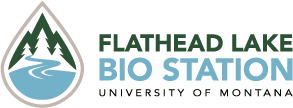The 2025 FLBS AIS Report: Montana's AIS Team Named Best in the West
For decades, the University of Montana’s Flathead Lake Biological Station (FLBS) has played a pivotal role in Montana’s vigilant and joint efforts to prevent the arrival and spread of aquatic invasive species (AIS) in Big Sky Country.
This year, FLBS and the entire Montana AIS early detection and prevention collaborative team were recognized by the Western Regional Panel on Aquatic Nuisance Species as “Best in the West” for their exceptional efforts in preventing the spread of invasive species.
The recognition is well-deserved. Once again, watercraft inspection stations worked tirelessly throughout the summer. Inspectors conducted over 119,000 inspections, a process that included the inspection of over 20,000 high risk boats and the decontamination of thirty-eight mussel-fouled watercraft.
FLBS AIS monitoring program, meanwhile, continued to expand the efficiency and effectiveness of AIS early detection—another critical line of AIS defense that is keeping our waters clean and blue for generations to come.
“Early detection of an invasive species in the introduction phase can make a profound impact,” said FLBS AIS specialist Phil Matson. “The earlier the detection, the better our odds are at limiting the chance of establishment and eradicating that species before extensive spread takes place that we cannot contain.”
Partnering with the Confederated Salish and Kootenai Tribes (CSKT) and Montana Fish, Wildlife & Parks (FWP), FLBS AIS specialist Phil Matson and his team conducted three rounds of sample collection from thirty-one different sites around Flathead Lake. FLBS scientists also conducted two rounds of sample collection from six additional Flathead Watershed lakes, including Swan Lake, Ashley Lake, Echo Lake, Little Bitterroot Lake, Lake Mary Ronan, and Hungry Horse Reservoir.
This monitoring is to ensure that—should a mussel-infested boat somehow make it into our waters without getting cleaned, drained, and dried—the invading mussels or other AIS are detected as early as possible. Accurate early detection plays a key role in the ability of stakeholders and managers to respond to the arrival of zebra or quagga mussels and prevent invasion.
No evidence of invasive mussels has been detected in any of the samples from the Flathead Watershed processed thus far.
But the impact of the FLBS AIS program goes beyond sample collection. Matson and his team also provide impactful education and outreach opportunities sharing important information about the threats that AIS pose and the statewide efforts underway to prevent their spread.
In June, the FLBS AIS team hosted a day-long AIS training in conjunction with FWP. Participants from federal, tribal, and state agencies joined members of local watershed associations to learn native and non-native aquatic species identification, sampling techniques for microscopy and genetic detection techniques (i.e., PCR analysis), and environmental DNA best management protocols. Following the training, participants had the opportunity to join the FLBS AIS team during sampling events to put their newly acquired skills to go use.

FLBS educators and AIS specialists join representatives from CSKT, FWP, and more to provide hands-on learning opportunities for middle school students during a Mussel Walk in Polson, MT.
Additionally, FLBS AIS team member and Big Sky Watershed Corps member, Evan Youngblade was a regular inspector at the Swan Lake watercraft inspection station run by the Swan Lakers watershed group, another strong partner in the battle against AIS. Evan worked side by side with Swan Lakers volunteers, including Swan Lakers President Jeff Kemp who was also recognized by the Western Regional Panel as “Best in the West” in 2025.
The FLBS AIS program also teamed up with our FLARE K-12 program, CSKT, and FWP to host the popular Mussel Walk and Lake Honoring events, which provide students from local K-12 schools the opportunity to learn about lake ecology and AIS prevention. This year over 250 students surveyed Flathead Lake beaches for mussels and other invasive species and gained a deeper respect for protection our aquatic resources.
“Prevention is the best strategy we have,” said Matson. “Engaging and educating our youth not only fosters future protectors of our waters, but also helps bring that message inside the home when those students share what they’ve learned around the dinner table.”
Recently, Matson was reappointed to another four-year term as a citizen-at-large voting member on the Western Montana Conservation Commission, a State of Montana organization that identifies and addresses threats to the waters of the upper Columbia Basin, where he also serves as the AIS Committee Chair and sits on the Monitoring Committee.
“My hope is that our policy makers will continue to understand our collective prevention efforts are a business investment,” he said. “By supporting our conservation efforts, we ensure both the ecological and economic sustainability of our priceless natural resources.”


